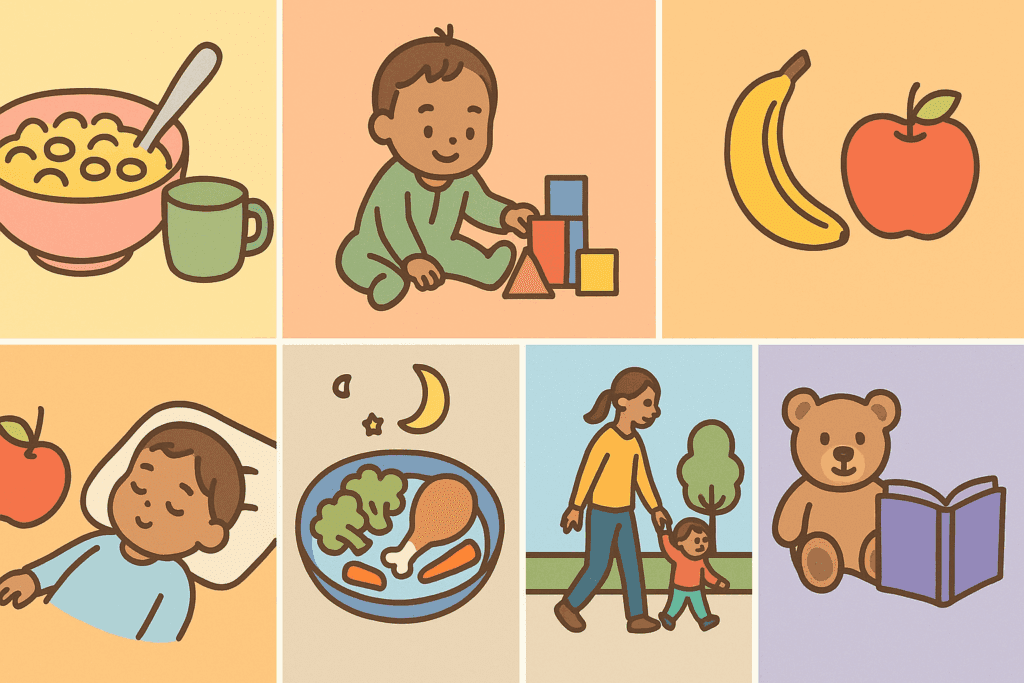Weaning is a monumental milestone in an infant’s nutritional and emotional development. For many families, determining how to wean off breastfeeding at 12 months involves a thoughtful blend of timing, sensitivity, and nutritional planning. At the one-year mark, babies are transitioning from exclusive milk feedings to a more complex diet of solids, and with that transition comes the emotional adjustment of letting go of the comfort and bonding time breastfeeding provides. This process is neither sudden nor one-size-fits-all. Rather, it’s an adaptive journey tailored to a child’s developmental readiness and the caregiver’s goals, lifestyle, and cultural context. Understanding this transition requires recognizing not only the biological cues that suggest a baby is ready to move on from nursing but also the evolving nutritional needs that shape a child’s diet as they continue to grow.
One of the most common concerns among parents and caregivers is knowing when and how to initiate this change. Navigating this stage requires more than just removing breastfeeds; it demands knowledge of what is weaning, how babies signal readiness for this transition, and how best to structure the change so that nutritional adequacy and emotional security are both maintained. Especially at 12 months, when a child is becoming more active, curious, and socially aware, weaning must balance independence and intimacy, nourishment and nurture. The best approaches are gradual, deliberate, and rooted in evidence-based child development and nutrition principles.
You may also like: Essential Milestones in Baby Led Weaning: A Proven Guide to Nurturing Healthy Eating Habits

Understanding What Is Weaning and Why It Matters at 12 Months
To truly grasp how to wean off breastfeeding at 12 months, it’s important to first understand the concept of weaning itself. Weaning is the gradual process of transitioning a baby from breastfeeding or formula feeding to solid foods and other sources of nutrition. While many associate weaning exclusively with food, it’s equally an emotional and behavioral shift. For the baby, nursing isn’t only about hunger but also comfort, security, and emotional regulation. The process involves a redefinition of feeding routines and maternal-infant bonding experiences.
At around the one-year mark, the nutritional dynamics of a child’s needs begin to change. Breast milk continues to provide valuable immune support and nutrients, but it’s no longer sufficient as the sole source of nutrition. Introducing more solid foods, and increasing their diversity and complexity, becomes essential for ensuring adequate intake of protein, iron, calcium, and vitamins. This is when the transition from milk to meals begins in earnest, making this stage a natural point to begin reducing nursing sessions.
Weaning at 12 months aligns with many pediatric recommendations that encourage breastfeeding for at least the first year but allow flexibility beyond that based on the child’s needs and the family’s preferences. Knowing what comes before weaning also helps set realistic expectations. Babies are usually introduced to complementary foods at 6 months, meaning that by their first birthday, they already have six months of solid food experience. This makes it easier to integrate new textures, tastes, and feeding routines into their day.
The benefits of timely and well-managed weaning include smoother digestion, improved nutrient absorption from a varied diet, and greater engagement in family mealtimes. More importantly, it supports cognitive and motor development by encouraging self-feeding, chewing, and participation in structured eating times. Emotionally, well-paced weaning supports the baby’s growing sense of independence while ensuring that attachment bonds are not abruptly disrupted.

Signs Baby Is Ready to Wean from Breastfeeding
Recognizing the signs baby is ready to wean from breastfeeding is essential for ensuring that the transition is both timely and successful. Each child is unique, and readiness can manifest in subtle, personalized ways. However, there are several common developmental and behavioral cues that signal a baby may be prepared to begin the weaning journey.
One of the clearest indicators is a declining interest in nursing, especially when offered during routine times. A baby who turns away from the breast, becomes easily distracted during feedings, or prefers solid foods when given a choice may be signaling natural readiness for a shift. This declining enthusiasm for breastfeeding often coincides with developmental leaps in mobility and social interaction. As babies become more mobile and curious about their environment, their attention span for nursing may shorten.
Another sign is the ability to consume a variety of solid foods in adequate quantities. If a baby is eating three balanced meals a day and showing interest in snacks or finger foods, they may no longer need as many milk feedings. This behavioral readiness, combined with the physiological ability to chew, swallow, and digest solids comfortably, suggests that their digestive system is maturing appropriately.
Babies may also start to develop self-soothing behaviors that replace the comfort they previously derived from breastfeeding. For example, they may take an interest in cuddling with a favorite blanket, snuggling with a caregiver, or engaging in quiet time without nursing. These shifts in emotional coping strategies can be important markers that your child is becoming more self-regulated.
Additionally, night weaning often begins to occur naturally around this age. Babies who sleep through the night without nursing or wake for comfort rather than nourishment may be ready for a more consistent daily feeding schedule that doesn’t include nighttime nursing. These patterns provide valuable insights into how to wean infant off breastfeeding without disrupting sleep routines or emotional well-being.

How to Wean Off Breastfeeding at 12 Months While Supporting Nutrition
Learning how to wean off breastfeeding at 12 months requires a strategic, compassionate approach that considers both nutritional and emotional factors. This process should be gradual, ideally taking place over several weeks or months, allowing the child and caregiver to adjust with minimal stress. It’s important to understand that weaning doesn’t mean removing breast milk abruptly, but rather slowly decreasing reliance on it while introducing more varied and nutrient-dense foods.
One of the most effective techniques is to begin by eliminating one nursing session every few days, starting with the one your baby seems least interested in. Midday feedings, for example, are often easier to replace with snacks or meals because the child is typically active and distracted. Replacing nursing with a healthy, filling solid meal can ease the transition without making the child feel deprived.
Throughout this process, ensuring that your baby receives adequate hydration is crucial. At 12 months, water and whole milk (or fortified plant-based alternatives, if appropriate) can be gradually introduced to meet fluid needs. These should never replace meals but serve as part of a balanced dietary approach. Monitoring urine output and energy levels can help you assess whether your baby is staying well hydrated as they reduce breast milk intake.
From a nutritional perspective, focus on building balanced meals that include proteins, healthy fats, complex carbohydrates, fruits, and vegetables. Iron-rich foods are particularly important at this age since breast milk alone may no longer meet iron requirements. Including sources such as fortified cereals, legumes, leafy greens, and lean meats can help support this need.
Finally, emotional reassurance during weaning is as important as nutritional planning. Cuddling, storytelling, and one-on-one time can replace the closeness of nursing and maintain emotional bonds. Consistency and gentle transitions make the process smoother for everyone, especially when weaning from nursing is paired with comforting routines and predictable mealtimes.

Creating a Gentle Weaning Schedule for a 1-Year-Old
A well-structured weaning schedule can help ensure that the transition away from breastfeeding is both developmentally appropriate and emotionally supportive. When deciding how to stop breastfeeding for 1 year baby milestones, it’s essential to tailor the schedule based on the child’s feeding habits, temperament, and nutritional status. A flexible plan that accommodates both gradual change and responsiveness to cues is often the most effective.
Begin by keeping track of when your baby typically nurses during the day and how long those sessions last. This helps identify natural opportunities for replacement with solid meals or snacks. Once patterns are clear, you can begin by removing one nursing session every three to five days. It is often advisable to start with daytime feedings, as these are more easily replaced with structured meals and interactive distractions.
Morning and bedtime nursing sessions are often the most emotionally significant, so they should be the last to go. During the day, offer filling snacks such as yogurt, cheese, whole-grain crackers, or avocado to keep your baby satiated. Use mealtime as an opportunity to introduce new foods, textures, and flavors, reinforcing the concept that nourishment and pleasure can come from the dining experience, not just breastfeeding.
Incorporating rituals such as handwashing before meals, using a special cup, or sitting at the table can provide a sense of structure and routine that supports the weaning transition. Babies thrive on predictability, so a consistent feeding schedule that mirrors your child’s natural rhythms can reduce resistance and increase comfort.
Nighttime weaning requires additional care. If your baby still nurses to sleep, consider shifting to a soothing bedtime routine that includes a bath, storytime, and gentle music. Gradually shortening the duration of nighttime feeds before phasing them out can also be effective. Parents often find success when they replace nursing with other soothing methods, such as patting, rocking, or offering a comfort object, which can ease the separation from breast milk during this sensitive time.

How to Stop Breastfeeding for 2 Year Baby: Key Differences and Strategies
While many of the principles of baby weaning apply universally, learning how to stop breastfeeding for 2 year baby presents unique challenges and opportunities. A toddler who has breastfed well beyond infancy often has stronger emotional attachments to nursing and may view it as a vital part of daily routines, comfort, and stress management. This makes the process more psychologically complex, requiring additional planning, patience, and emotional support.
At this age, communication becomes a powerful tool in the weaning process. Unlike younger infants, toddlers can often understand explanations and respond to verbal cues. Parents can begin by discussing upcoming changes in gentle, age-appropriate language, preparing the child for what to expect. Reading picture books about weaning or talking about “big kid” meals can help set expectations and generate excitement.
Creating a detailed weaning schedule that accounts for your toddler’s preferences, sensitivities, and daily rhythms is particularly important. Begin by gradually limiting nursing to specific times of day—for example, only at bedtime or nap time—and then phasing those sessions out one by one. Substituting breastfeeds with special activities, such as a walk, snack, or favorite song, can help redirect the child’s focus and meet emotional needs in different ways.
Nutritionally, two-year-olds should already be consuming a wide range of solid foods. Continue offering a variety of fruits, vegetables, whole grains, proteins, and healthy fats to support development. Calcium and vitamin D remain essential for bone growth, so ensure adequate intake through dairy products or fortified alternatives. As toddlers become more autonomous, involving them in food choices and mealtime routines can reinforce positive associations with eating and encourage independence from breastfeeding.
Emotionally, weaning at this age is a two-way street. It’s important to check in with your own feelings as a caregiver, as the bond shared through extended nursing can be deeply meaningful. Balancing empathy with firmness, and offering consistent affection and attention outside of nursing times, can make this transition smoother for both parties.

Proven Ways to Wean Breastfeeding Without Disrupting Emotional Bonds
As you continue the journey of weaning, it’s crucial to address not just the physical act of reducing breastfeeds, but also the emotional landscape that surrounds it. The ways to wean breastfeeding effectively often revolve around reinforcing your child’s sense of safety, trust, and connection in new forms. Responsive parenting during this period can make a significant difference in how the child copes with the loss of nursing. Many parents find that substituting the breastfeeding routine with comforting rituals—like cuddling, reading books, or a special song—helps preserve the emotional closeness that nursing once provided.
Another powerful strategy is to adopt a “don’t offer, don’t refuse” approach. This method encourages natural weaning by allowing the child to initiate breastfeeding less frequently over time, without the parent actively offering it. When the child does ask to nurse, especially in the early stages of weaning, honoring the request while gently guiding them to shorter feeds can promote a respectful and gradual transition.
Maintaining consistent routines throughout the day is another cornerstone of successful weaning from nursing. Children thrive on predictability, and structured daily activities that include shared meals, outdoor play, and quiet rest times help fill the void left by breastfeeding. These rituals not only support the child emotionally but also promote a sense of routine and stability, reducing clinginess or tantrums related to the change.
For children who show signs of anxiety during weaning, such as increased night waking or clinginess, offering extra affection and physical closeness throughout the day can be a powerful reassurance. This is particularly important during naps and bedtime, when nursing may have been the primary soothing method. Comforting alternatives like rocking, patting, or a warm bath can serve as emotional anchors as your child adapts.
Ultimately, understanding how to wean off breastfeeding at 12 months is about more than nutritional transitions. It is also a testament to nurturing emotional resilience and teaching children that comfort and love remain constant, even when the method of delivery changes. Taking time to respect both your child’s pace and your own emotional journey ensures that the weaning process strengthens your bond, rather than strains it.

What Comes Before Weaning: Laying the Groundwork for a Smooth Transition
Before families begin to wean, it’s important to understand what comes before weaning to ensure the transition is grounded in readiness and stability. The months leading up to weaning, particularly from around six months onward, involve critical steps that help prepare both the baby and the caregiver for this shift. These months offer the ideal window for introducing complementary feeding, which sets the stage for reducing milk dependency.
Complementary feeding begins when breast milk or formula alone no longer satisfies the baby’s nutritional needs. This generally occurs around six months, a period marked by developmental readiness for solids. During this phase, babies explore a variety of textures and flavors through mashed fruits, pureed vegetables, and iron-fortified cereals. Encouraging positive associations with eating and allowing the baby to self-feed where possible are important developmental milestones that smooth the transition from breast milk.
Equally important is creating a nurturing and consistent feeding environment. Babies learn about food and mealtime behaviors by observing their caregivers, so participating in family meals, sitting at the table, and mimicking eating behaviors help lay a solid foundation. This early exposure to structured meals reduces resistance later when breast milk is no longer the central source of nourishment.
Developing sleep and wake routines also plays a role in preparing for weaning. Babies who have predictable nap and nighttime patterns often transition more easily away from nursing, especially during night weaning. Establishing bedtime rituals that include activities other than feeding—such as reading a book, singing lullabies, or a warm bath—teaches the baby to associate comfort with experiences other than breastfeeding.
Finally, understanding your baby’s individual temperament and feeding style is key. Some babies are naturally curious about food and quickly embrace solids, while others may need repeated exposures and reassurance. Monitoring cues and being flexible in your approach ensures that the weaning process is adapted to the baby’s needs. Setting these foundations makes it easier to apply the many ways to wean breastfeeding effectively once the time arrives.
When to Stop Breastfeeding: Timing Considerations and Individual Readiness
Determining when to stop breastfeeding is a deeply personal decision that must balance expert recommendations, nutritional adequacy, family circumstances, and the child’s readiness. The World Health Organization recommends breastfeeding up to two years and beyond, but this is not a mandate; it’s a guideline that allows for individualized weaning based on a child’s developmental and emotional cues.
Some families may choose to stop breastfeeding at 12 months, aligning with the nutritional shift toward solid foods and increasing autonomy. Others may continue well into toddlerhood, especially if nursing remains a source of comfort or if health conditions suggest benefits in extending breastfeeding. There is no universal “correct” age; rather, the focus should be on recognizing when breastfeeding no longer serves the family in a balanced and healthy way.
For some children, when to stop nursing becomes evident when they show clear signs of independence. These might include skipping nursing sessions, preferring cups over the breast, or eating full meals with enthusiasm. Conversely, signs of readiness may also emerge gradually, such as increased night sleep without feeds or longer intervals between nursing.
Parents often find that external factors influence the timing of weaning. Returning to work, health concerns, or the desire to conceive another child are all valid considerations. It’s important, however, to ensure that these decisions are supported by a gradual plan that meets the child’s emotional and nutritional needs. Abrupt weaning can lead to distress, confusion, or even physical discomfort for both mother and child.
Ultimately, the timing of weaning should reflect a balance between the child’s cues and the caregiver’s well-being. Open communication with pediatricians and lactation consultants can provide valuable guidance, especially when navigating medical or emotional uncertainties. Whether at 12 months or beyond, the goal is to make the weaning experience a positive step forward in the child’s nutritional journey.
Frequently Asked Questions: Navigating How to Wean Off Breastfeeding at 12 Months
What are some advanced signs baby is ready to wean from breastfeeding beyond the basics?
Beyond reduced interest in nursing or increased intake of solid foods, a more advanced sign that a baby is ready to wean from breastfeeding includes their ability to self-regulate hunger and satiety. A baby who can indicate when they are full or hungry and who responds predictably to structured mealtimes shows signs of readiness. Additionally, babies who begin to mimic adult eating behavior, like using utensils or showing interest in the family’s food, are often developmentally ready for this shift. Cognitive milestones, such as understanding simple instructions and routines, also support smoother baby weaning experiences. Emotional independence, such as the ability to be comforted without the breast, can be another strong indicator that a baby is prepared for weaning from nursing.
How do caregivers create emotional continuity during the weaning schedule?
Creating emotional continuity while implementing a weaning schedule involves building new rituals that offer security and comfort. For example, caregivers can replace nursing sessions with cozy story time, a special bedtime song, or quiet cuddle time. These rituals can help establish a predictable rhythm and reinforce emotional bonds. It is also helpful to maintain consistent mealtimes and nap routines to provide structure and reduce anxiety. The child should still receive plenty of one-on-one attention throughout the day to avoid feeling a sudden emotional void as they transition away from breastfeeding.
How to wean off breastfeeding at 12 months without compromising immunity?
Parents often worry about the immune support breast milk offers. While weaning off breastfeeding at 12 months does reduce some direct immune benefits, this gap can be addressed through nutrient-rich foods and a healthy environment. Offering foods high in vitamins C, A, D, and zinc—such as citrus fruits, sweet potatoes, leafy greens, eggs, and fortified cereals—can help strengthen your baby’s immune system. Daily outdoor activity, handwashing routines, and age-appropriate vaccines further support health during and after baby weaning. Some parents choose partial weaning, keeping morning or bedtime feeds a bit longer while introducing a robust diet.
What are innovative ways to approach baby weaning during travel or life transitions?
Weaning during travel or major life transitions, like starting daycare or moving homes, can be complex but manageable with strategic planning. Parents can use new environments as a natural distraction by introducing local foods or new feeding rituals. Using visual aids like books or pictures to explain the weaning schedule can also help toddlers understand changes. It is helpful to maintain portable versions of your home routines, such as a favorite weaning cup or bedtime stuffed animal. While consistency is important, so is flexibility; adjusting expectations during temporary disruptions will make baby weaning smoother and more emotionally manageable.
How to stop breastfeeding for 1 year baby when nursing is linked to sleep?
When breastfeeding and sleep are closely linked, transitioning requires a thoughtful strategy that uncouples the association. Begin by introducing a calming sleep routine that does not involve nursing, such as a warm bath, dimmed lights, gentle music, and storytime. Replace nursing with a comfort object or soothing motion, like rocking or back rubbing. It may also help to gradually reduce the time spent nursing before naps or bedtime instead of removing it abruptly. With consistency and patience, your 1 year baby can learn new, independent sleep associations while adapting to the weaning process.
Are there specific nutritional risks during the weaning process I should monitor?
During the transition away from breast milk, there is a temporary period where nutritional gaps may occur, especially if the child resists new foods. Key nutrients to monitor include iron, calcium, vitamin D, and healthy fats. Introducing iron-rich foods like lentils, spinach, and poultry is critical, especially since breast milk is no longer the main iron source. Full-fat dairy, fortified plant milks, and oily fish contribute to brain development and bone health. Pediatricians often recommend supplements during this time, particularly vitamin D, to bridge the gap during early weaning schedule adjustments.
How to stop breastfeeding for 2 year baby with strong emotional dependence?
Weaning a 2 year baby can be emotionally charged, especially if nursing has been a significant source of comfort. Communication plays a major role here; toddlers can understand explanations like “milk is for babies, and now we eat big kid food.” Gradually reducing nursing sessions while replacing them with engaging activities—like helping with meal prep or having a post-nap snack picnic—can shift focus from breastfeeding. Empathy is key: acknowledge their feelings and offer affection in other forms, such as more snuggles or playful routines. Celebrating small milestones during the process can also reinforce the child’s confidence and willingness to transition.
What is weaning in a cultural or historical context, and how does it shape modern practices?
What is weaning has evolved dramatically across cultures and centuries. In many traditional societies, weaning was a communal process where extended family participated in feeding and caregiving. Cultural foods, spiritual rites, and even weaning songs played a role in signaling a child’s transition. In modern settings, parents often manage weaning in isolation, relying on digital tools and medical guidance rather than intergenerational wisdom. Understanding this shift can help parents feel less pressured by modern timelines and more confident in customizing their approach. Exploring historical and cross-cultural perspectives reminds us that baby weaning is a deeply human, varied, and adaptable process.
How can I tell when to stop breastfeeding if the child isn’t showing clear cues?
Not all children give obvious signs for when to stop breastfeeding, so parents must consider a blend of physical, emotional, and developmental indicators. If a child eats three full meals, snacks independently, and shows interest in peer eating habits, they are likely ready to reduce milk intake. Caregivers should also assess their own readiness, energy levels, and lifestyle balance. In some cases, initiating a gentle weaning schedule may help prompt the child to adapt. Consulting with a pediatric nutritionist or lactation specialist can help clarify the ideal timing for families in such ambiguous situations.
Exploring New Horizons: How to Wean Off Breastfeeding at 12 Months with Confidence
Many parents wonder how to wean off breastfeeding at 12 months without causing emotional distress or nutritional disruption. Confidence comes from preparation, observation, and a supportive environment. Rather than using rigid deadlines, allow your child to lead in some areas while gently guiding them through structured routines. Encourage participation in mealtimes, offer a variety of textures, and celebrate small milestones in the journey. Weaning doesn’t have to be a loss; when done mindfully, it becomes a developmental springboard into a world of independence, exploration, and joy.
Conclusion: The Final Step: A Thoughtful Conclusion to Weaning and Healthy Childhood Nutrition
Successfully completing the weaning process at or around 12 months marks an important milestone in a child’s early development. It’s a time not just of dietary change, but of growth in independence, emotional maturity, and family dynamics. When considering how to wean off breastfeeding at 12 months, it becomes clear that the decision encompasses far more than replacing breast milk with solid foods. It represents a transition into toddlerhood—a stage where new skills, preferences, and nutritional needs begin to take center stage.
Reflecting on the weaning journey highlights how interconnected nutrition and emotional well-being truly are. As children move away from nursing, their eating habits evolve to include more varied and balanced meals. This shift supports physical growth, cognitive development, and lifelong eating behaviors. Establishing healthy routines around food at this stage helps prevent picky eating, fosters curiosity about nutrition, and lays the groundwork for a healthy relationship with meals and mealtimes.
Emotionally, the end of breastfeeding can feel bittersweet for both child and caregiver. Yet, the process of weaning provides an opportunity to redefine closeness and security. Through shared experiences like reading stories, engaging in play, and maintaining consistent daily routines, caregivers can continue to nurture bonds while encouraging autonomy. The child learns that love and safety are not limited to the act of nursing, but are embedded in the rhythm and rituals of daily life.
From a broader perspective, understanding how to wean breast milk and transition into toddlerhood aligns with public health goals for childhood nutrition. It empowers families to adopt evidence-based feeding practices, reducing reliance on formula or breast milk while emphasizing whole foods and appropriate textures. It also creates space for other caregivers to participate more fully in feeding routines, fostering social development and adaptability in the child.
Above all, weaning should be viewed not as an end, but as a beginning. It is the opening chapter in the child’s journey toward self-sufficiency, resilience, and well-being. Whether you are navigating how to stop breastfeeding for 1 year baby or extending the process for a toddler, the principles remain the same: observe your child, honor their pace, and prioritize both nutritional and emotional needs.
In closing, remember that every family’s weaning journey is unique. While expert guidelines can offer structure, your lived experience, intuition, and your child’s individuality are the most important guides. The gentle, respectful path you take today will shape not only your child’s diet, but also their trust in the world and their sense of security in new transitions. With patience, compassion, and informed decision-making, weaning becomes a deeply affirming step in the lifelong story of healthy growth and nutrition.
Further Reading:
How you wean your child will depend on their age and how quickly you want to stop breastfeeding



